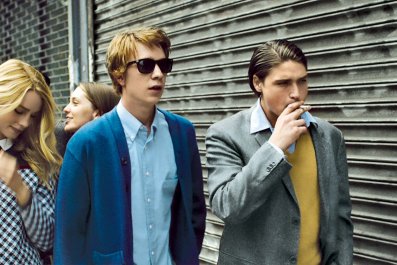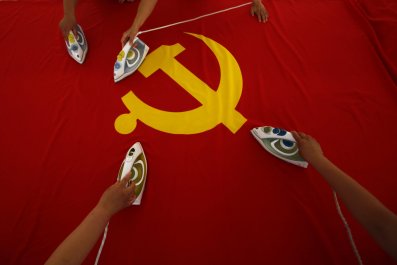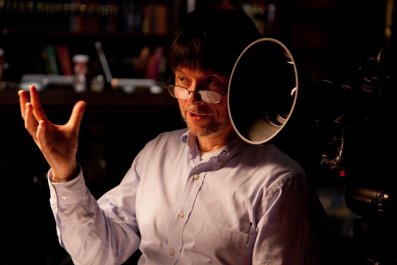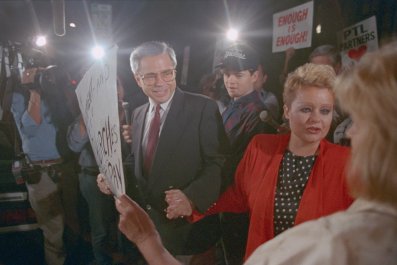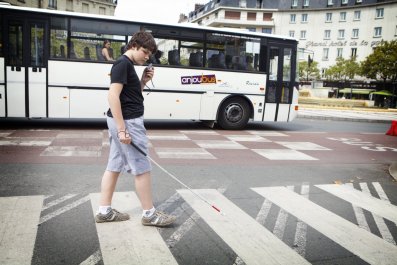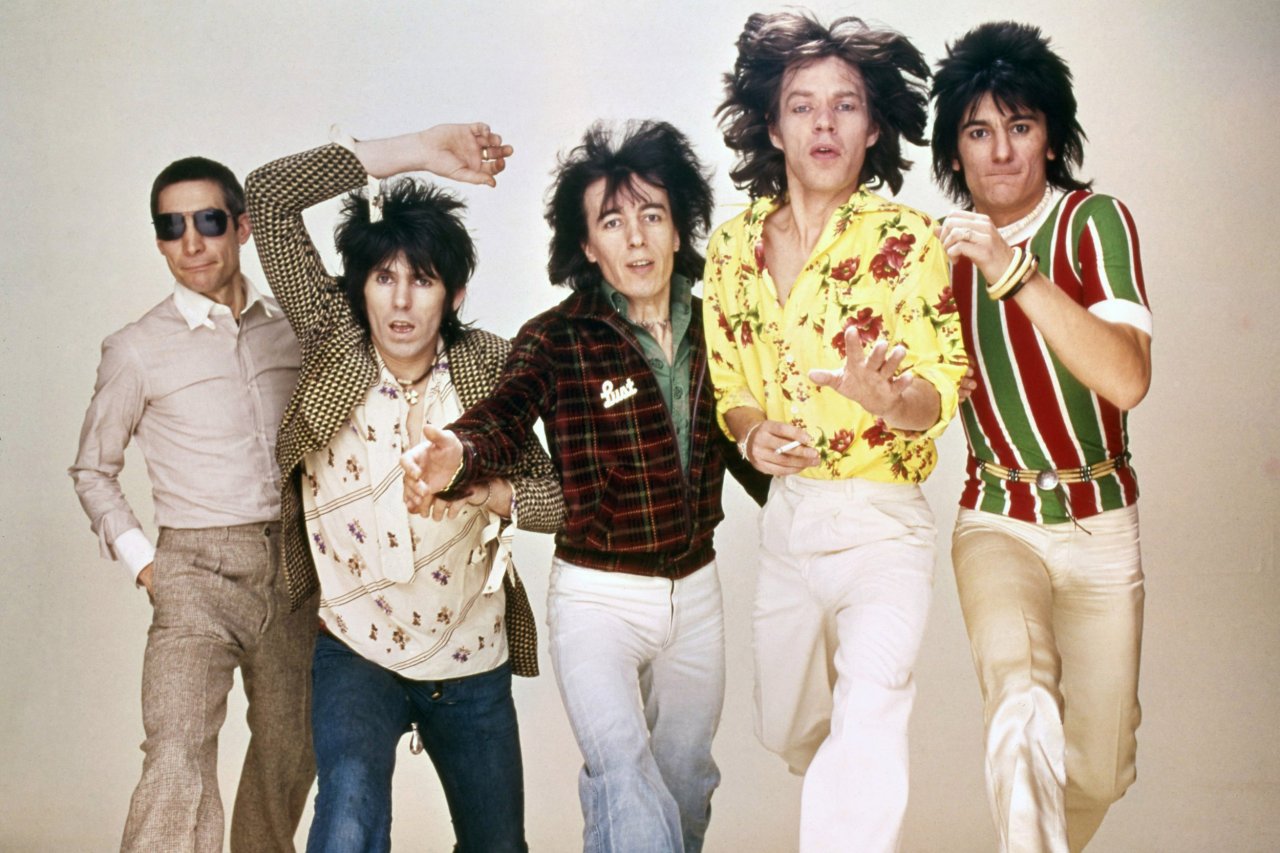
London's Saatchi Gallery is preparing for something big. On April 5, doors will open to its latest show, "Exhibitionism: The Rolling Stones." A project three years in the making, with a budget of $5.7 million, the contents of the band's first international exhibition have been a closely guarded secret. Tantalizing snippets have been released to the media, but no one knew quite what to expect.
That is, until now. The exhibition's lead curator, Ileen Gallagher, has told Newsweek what is contained within the show's nine rooms that sprawl across two of the gallery's vast floors. Fans will find themselves in a replica of the band's first flat, then a typical recording studio and finally the group's backstage area. A 3-D film will transport visitors to being onstage with the Rolling Stones while stage lights dazzle above. And amid all this are the hundreds of items the band has collected over the decades: instruments, notebooks, jumpsuits, photos and ephemera.
To call "Exhibitionism" an exhibition does not do it justice. It is an extravaganza, already scheduled to visit 11 cities over the next four years. A host of celebrities have pulled it together, among them Martin Scorsese, Anna Sui, Tommy Hilfiger, John Varvatos and Buddy Guy. And, in keeping with the Rolling Stones' love of excess, it will dwarf even the Victoria and Albert's monumental David Bowie retrospective.
But what, some critics may wonder, can the show offer that isn't already known? Unlike Bowie, the Rolling Stones have always sought the limelight. The longest-running rock band in the world—though members have come and gone—has courted controversy throughout its career of more than 50 years. In 2010, guitarist Keith Richards lifted the lid on all the drama and debauchery with his memoir Life, which discussed the band's love of sex, drugs and rock 'n' roll in extensive detail.
But "Exhibitionism" doesn't bother with the salacious details. It's the band stripped bare, studied through the members' things—not their exploits. Put simply, it's the most in depth look at the Rolling Stones in half a century. "We did not take a chronological approach," Gallagher says. "We looked at the band's career thematically and tried to create an atmosphere for people to immerse themselves in."
Two rooms, Ladies and Gentlemen and then Experience, serve as the introduction to the show. Entering Ladies and Gentlemen, one finds a room bathed in red displaying two quick animations. The first details the entirety of the band's world travels and the people they have played to. The second presents the number of songs and albums they have produced.
Moving into Experience, attendees are met by a semicircular wall of 60 video screens that shows a montage of the Rolling Stones' career, a chronological look at the totality of their work. The screens sometimes have one huge image or five to 10 pictures scattered among them.
Introductions made, visitors are led through a tunnel to the third room, Meet the Band. While walking through the tunnel, they hear an audio track lead singer Mick Jagger and guitarist Keith Richards discussing how they met.
The tunnel turns and opens onto a re-creation of the band's first apartment at Edith Grove in Chelsea. "It's a fun, disgusting recollection of the flat," Gallagher says. "All of it's there, the fungi that grew there and the smell—dirty socks, beer and cigarettes."
Another curator, Patrick Woodroffe, who has served for 30 years as creative director for all the Rolling Stones' live shows, recalls drummer Charlie Watts telling him: "It was the most disgusting and filthy flat I've ever been to in my life." When Woodroffe said the band should reproduce the smell of the place, he suggested that they infuse the gallery room with patchouli oil. "We were not really a patchouli oil band," Watts told him. Richards added: "Patchouli?! We could not even afford it."
The rest of the room focuses on the band, marking the moment they began to tour the U.K. The band members are introduced through dozens of fan photos, spilling out over the floor. Watts's first drum kit is on display as is Richards's diary from 1963 and former Stones bassist Bill Wyman's amplifier that he used in his initial audition for the band. Accompanying that is a video narrated by Buddy Guy, Jagger and Richards about the influence blues has had on the band and how the group has influenced the form.
The group's influence on music in general is seismic. The Rolling Stones have produced a staggering 29 studio albums, not to mention their live and compilation albums. From Meet the Band, "Exhibitionism" takes visitors to Recording, to see where the music was made. Attendees enter a replica of a typical recording studio used by the band. Original instruments are on display with a video projection of the band in session. Accompanying this are interactive iPads that show Richards and producer Don Was talking about recording.

The third part of the room has a collection of musical instruments the band has played over the decades. There's audio of Richards and Jagger talking about songwriting, as well as several of Jagger's original notebooks. Gallagher describes this as one of her favorite moments in the exhibition.
Given the iconic status of the Rolling Stones, it's hardly surprising that their influence has spread beyond music to art, literature and film. "Exhibitionism" covers the band's influence on the latter as it leads visitors away from Recording to a Film and Video, a small screening area. There, movie director Martin Scorsese talks visitors through the seminal moments of the Stones on film. Scorsese's performance over, visitors can then watch a fast-paced montage of all of the band's 30 music videos.
From film, the show moves to the band's artistic legacy. This room charts the evolution of John Pasche's famous lips logo through a range of artwork and corresponding text. Also on display are the band's album covers as well as posters promoting their tours, all accompanied with words from Jagger.
The Rolling Stones' creative leanings can also be found in their stage and set designs, where bigger is always better. Jagger has strutted his stuff on stages shaped like the lips logo, or soared above the crowd on platforms that reach the stadium's roof. In homage to this, "Exhibitionism" has built small-scale models of three of the Rolling Stones' stages for the Voodoo Lounge, Steel Wheels and Bridges to Babylon tours.
The group became renowned not just for their live shows but what they, particularly Jagger, wore to perform them. For him, rock 'n' roll meant jumpsuits and glitter, later it came to mean high fashion. In accordance with this, Style, the room dedicated to the band's costumes, is split into four distinct eras. First comes the period when the band lived on the King's Road, Chelsea during the 1960s. "Their stage clothes were the same as their street clothes," Gallagher says.
Then came the band's glam era, spanning from 1969 to 1989. On show are costumes from the Rolling Stones' 1968 Hyde Park concert and their appearance at the notorious Altamont Speedway Free Festival in 1969 during which four people died.

After the glam period comes a look at the band's love of high-end fashion. Pieces are on display from the designers Alexander McQueen, Christian Dior, Ossie Clark, Yves Saint Laurent and L'Wren Scott, Jagger's partner until her death in 2014.
Finally, the room showcases the eight different outfits Jagger has worn to perform "Sympathy for the Devil," along with a video screen showing the various performances. An associate of the band who asked to remain anonymous added that when Gallagher went to explore Jagger's wardrobe, crucial pieces were missing. "Mick's daughters had nicked his clothes to wear to the fashion houses," the source says.
Fortunately for Gallagher, the Rolling Stones saved a lot of their other possessions from their children. In Rare, the most irreverent room in the exhibition, a collection of random items belonging to the band are jumbled together in what Gallagher describes as "a fun potpourri of stuff.… It's like going into their attic." Jagger, she says, prefers to call it "a cabinet of curiosities." It includes the barber chair Jagger took on tours to sit in while makeup artists went to work. There's Watts's bathrobe with patches sewn onto it for each tour, Ronnie Woods's set list and a stuffed model of the donkey similar to the live one used for the Get Yer Ya-Ya's Out! album cover, which was released in 1970.
The final room, Performance, re-creates the area the band uses immediately behind the stage. In the replica, Jagger's quick change tent is on display as well as guitars and wardrobe trunks. "It's the holy of holies that's never seen," Woodroffe says. "It's a dark, claustrophobic place, and then you walk into the live show," he adds. This, the creation of which Woodroffe also oversaw, involves a spectacular lighting display and a 3-D video of the band's 2013 performance in Hyde Park, which took the Performance team three to four months to create. Woodroffe hopes visitors will get a sense of what it's like to be onstage, to live the experience the Rolling Stones do.
And it's not an experience they plan to give up, Gallagher says: "We avoided chronology, because there's no end point. I think Keith says it best with his introductory text: 'It's too early for me to talk about the Stones' legacy. We have not finished yet. There's one thing we have not yet achieved and that's to really find out how long you can do this. It's still such a joy to play with this band that you cannot really let go of it."
"Exhibitionism" is at the Saatchi Gallery in London from April 5 to September 4. Tickets are 19 pounds.




